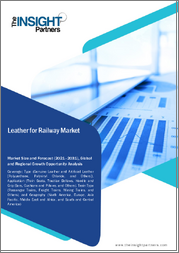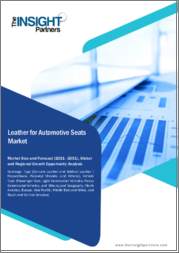
|
시장보고서
상품코드
1670185
자동차용 내장 레더 시장 규모, 점유율, 성장 분석 : 소재별, 차종별, 용도별, 판매채널별, 지역별 - 산업 예측(2025-2032년)Automotive Interior Leather Market Size, Share, and Growth Analysis, By Material (Genuine Leather, Synthetic Leather), By Car Class (Economy Car, Mid-range Car), By Vehicle Type, By Application, By Sales Channel, By Region - Industry Forecast 2025-2032 |
||||||
세계의 자동차용 내장 레더 시장 규모는 2023년에 233억 달러로 평가되며, 2024년 245억 1,000만 달러에서 2032년에는 367억 7,000만 달러로 성장하며, 예측 기간(2025-2032년)의 CAGR은 5.2%로 성장할 전망입니다.
자동차 내장재 가죽 시장은 기술 발전과 고급스러움에 대한 소비자의 기대치가 높아짐에 따라 크게 성장하고 있습니다. 최근 환경 친화적인 무두질 공정의 혁신은 우수한 품질과 성능 표준을 유지하면서 환경 문제를 해결하고 있습니다. 생산자들은 다양한 마감과 질감을 매끄럽게 통합하여 가죽의 시각적, 촉각적 매력을 높이고 전반적인 차량 내부 경험을 향상시키기 위해 노력하고 있습니다. 전 세계에서 가처분 소득이 증가함에 따라 고급 소재가 특징인 프리미엄 자동차에 대한 수요가 더욱 증가하고 있습니다. 또한 자동차 제조업체들은 난방 및 환기 기능이 있는 시트와 같은 고급 기능을 도입하여 까다로운 소비자들을 만족시키고 있습니다. 전기자동차와 자율주행차로의 전환은 새로운 기회를 가져왔으며, 자동차 제조업체들은 기존 가죽과 동일한 고급스러움과 편안함을 제공하는 지속가능하고 가벼운 대안을 모색하고 있습니다.
목차
서론
- 조사의 목적
- 조사 범위
- 정의
조사 방법
- 정보 조달
- 2차와 1차 데이터 방법
- 시장 규모 예측
- 시장의 전제조건과 제한
개요
- 세계 시장 전망
- 공급과 수요 동향 분석
- 부문별 기회 분석
시장 역학과 전망
- 시장 개요
- 시장 규모
- 시장 역학
- 촉진요인과 기회
- 억제요인과 과제
- Porter의 산업 분석
주요 시장 인사이트
- 주요 성공 요인
- 경쟁의 정도
- 주요 투자 기회
- 시장 에코시스템
- 시장의 매력 지수(2024년)
- PESTEL 분석
- 거시경제 지표
- 밸류체인 분석
- 가격 분석
- 규제 상황
- 사례 연구
자동차용 내장 레더 시장 규모 : 소재별
- 시장 개요
- 가죽
- 합성피혁
- 세미 아닐린 레더
자동차용 내장 레더 시장 규모 : 차종별
- 시장 개요
- 이코노미 카
- 중급차
- 고급차
자동차용 내장 레더 시장 규모 : 차종별
- 시장 개요
- 승용차
- SUV
- 상용차
자동차용 내장 레더 시장 규모 : 용도별
- 시장 개요
- 시트
- 대시보드
- 도어 패널
- 기타
자동차용 내장 레더 시장 규모 : 판매채널별
- 시장 개요
- OEM
- 애프터마켓
자동차용 내장 레더 시장 규모
- 북미
- 미국
- 캐나다
- 유럽
- 독일
- 스페인
- 프랑스
- 영국
- 이탈리아
- 기타 유럽 지역
- 아시아태평양
- 중국
- 인도
- 일본
- 한국
- 기타 아시아태평양
- 라틴아메리카
- 브라질
- 기타 라틴아메리카 지역
- 중동 및 아프리카
- GCC 국가
- 남아프리카공화국
- 기타 중동 및 아프리카
경쟁 정보
- 상위 5사의 비교
- 주요 기업의 시장 포지셔닝(2024년)
- 주요 시장 기업이 채택한 전략
- 최근 시장 동향
- 기업의 시장 점유율 분석(2024년)
- 주요 기업의 기업 개요
- 기업의 상세
- 제품 포트폴리오 분석
- 기업의 부문별 점유율 분석
- 매출의 전년대비 비교(2022-2024)
주요 기업 개요
- Lear Corporation(USA)
- Toyota Boshoku Corporation(Japan)
- Adient plc(Ireland)
- Grupo Antolin(Spain)
- Sage Automotive Interiors Inc.(USA)
- Elmo Sweden AB(Sweden)
- Scottish Leather Group Limited(UK)
- D.K Leather Corporation(Malaysia)
- Bader GmbH & Co. KG(Germany)
- WOLLSDORF LEDER SCHMIDT(Austria)
- GST AutoLeather, Inc.(USA)
- Seiren Co., Ltd.(Japan)
- Boxmark Leather GmbH & Co KG(Austria)
- Kyowa Leather Cloth Co., Ltd.(Japan)
- Leather Resource of America Inc.(Brazil)
- Katzkin Leather, Inc.(USA)
- Mayur Uniquoters Limited(India)
- Mingxin Automotive Leather Co., Ltd.(China)
결론과 제안
KSA 25.04.09Global Automotive Interior Leather Market size was valued at USD 23.3 billion in 2023 and is poised to grow from USD 24.51 billion in 2024 to USD 36.77 billion by 2032, growing at a CAGR of 5.2% during the forecast period (2025-2032).
The automotive interior leather market is witnessing substantial growth, driven by technological advancements and heightened consumer expectations for luxury. Recent innovations in eco-friendly tanning processes have addressed environmental concerns while maintaining superior quality and performance standards. As producers strive for seamless integration of diverse finishes and textures, they've elevated the visual and tactile appeal of leather upholstery, enhancing the overall in-car experience. Rising disposable incomes globally further boost demand for premium vehicles featuring luxurious materials. Manufacturers are also incorporating advanced features like heated and ventilated seats, catering to discerning consumers. The shift towards electric and autonomous vehicles presents new opportunities, prompting car makers to seek sustainable, lightweight alternatives that deliver the same luxury and comfort associated with traditional leather.
Top-down and bottom-up approaches were used to estimate and validate the size of the Global Automotive Interior Leather market and to estimate the size of various other dependent submarkets. The research methodology used to estimate the market size includes the following details: The key players in the market were identified through secondary research, and their market shares in the respective regions were determined through primary and secondary research. This entire procedure includes the study of the annual and financial reports of the top market players and extensive interviews for key insights from industry leaders such as CEOs, VPs, directors, and marketing executives. All percentage shares split, and breakdowns were determined using secondary sources and verified through Primary sources. All possible parameters that affect the markets covered in this research study have been accounted for, viewed in extensive detail, verified through primary research, and analyzed to get the final quantitative and qualitative data.
Global Automotive Interior Leather Market Segments Analysis
Global Automotive Interior Leather Market is segmented by Material, Car Class, Vehicle Type, Application, Sales Channel and region. Based on Material, the market is segmented into Genuine Leather, Synthetic Leather and Semi-aniline Leather. Based on Car Class, the market is segmented into Economy Car, Mid-range Car and Luxury Car. Based on Vehicle Type, the market is segmented into Passenger Cars, SUVs and Commercial Vehicles. Based on Application, the market is segmented into Seats, Dashboard, Door Panels and Others. Based on Sales Channel, the market is segmented into OEM and Aftermarket. Based on region, the market is segmented into North America, Europe, Asia Pacific, Latin America and Middle East & Africa.
Driver of the Global Automotive Interior Leather Market
A significant factor driving the growth of the global automotive interior leather market is the rising demand for premium and luxury vehicles. Consumers are increasingly pursuing high-quality and opulent interiors, with leather being a key component of this aspiration. As incomes continue to rise, particularly in developing regions, the appetite for luxurious cars has intensified. This trend is prompting automotive buyers to prioritize high-quality materials, with leather being sought after for its durability and aesthetic appeal. Consequently, the demand for leather in automotive interiors is surging, reflecting broader consumer preferences for sophistication and luxury in their vehicles.
Restraints in the Global Automotive Interior Leather Market
One significant restraint impacting the Global Automotive Interior Leather market is the growing emphasis on sustainability and environmental concerns. The automotive industry, particularly in the production of interior leather, faces scrutiny due to its environmental implications. The procedures involved in leather manufacturing, such as tanning and finishing hides, often utilize harmful chemicals and consume substantial amounts of water, raising red flags for environmentally conscious consumers and regulators alike. This increasing demand for eco-friendly practices presents challenges for manufacturers striving to balance traditional leather production methods with the need for sustainable options that minimize ecological impact and meet changing consumer expectations.
Market Trends of the Global Automotive Interior Leather Market
The Global Automotive Interior Leather market is experiencing significant growth driven by the rising popularity of electric and autonomous vehicles (EVs and AVs). As manufacturers pivot towards sustainable, technologically advanced interiors that enhance user experiences, there is a growing demand for high-quality leather, which meets these evolving needs. Leather's versatility allows it to seamlessly integrate with advanced features and functions while providing the durability and aesthetic appeal that modern consumers seek. This trend underscores a shift towards premium materials in vehicle design, positioning leather as a preferred choice among automakers aiming to align with sustainability and innovation goals.
Table of Contents
Introduction
- Objectives of the Study
- Scope of the Report
- Definitions
Research Methodology
- Information Procurement
- Secondary & Primary Data Methods
- Market Size Estimation
- Market Assumptions & Limitations
Executive Summary
- Global Market Outlook
- Supply & Demand Trend Analysis
- Segmental Opportunity Analysis
Market Dynamics & Outlook
- Market Overview
- Market Size
- Market Dynamics
- Drivers & Opportunities
- Restraints & Challenges
- Porters Analysis
- Competitive rivalry
- Threat of substitute
- Bargaining power of buyers
- Threat of new entrants
- Bargaining power of suppliers
Key Market Insights
- Key Success Factors
- Degree of Competition
- Top Investment Pockets
- Market Ecosystem
- Market Attractiveness Index, 2024
- PESTEL Analysis
- Macro-Economic Indicators
- Value Chain Analysis
- Pricing Analysis
- Regulatory Landscape
- Case Studies
Global Automotive Interior Leather Market Size by Material & CAGR (2025-2032)
- Market Overview
- Genuine Leather
- Synthetic Leather
- Semi-aniline Leather
Global Automotive Interior Leather Market Size by Car Class & CAGR (2025-2032)
- Market Overview
- Economy Car
- Mid-range Car
- Luxury Car
Global Automotive Interior Leather Market Size by Vehicle Type & CAGR (2025-2032)
- Market Overview
- Passenger Cars
- SUVs
- Commercial Vehicles
Global Automotive Interior Leather Market Size by Application & CAGR (2025-2032)
- Market Overview
- Seats
- Dashboard
- Door Panels
- Others
Global Automotive Interior Leather Market Size by Sales Channel & CAGR (2025-2032)
- Market Overview
- OEM
- Aftermarket
Global Automotive Interior Leather Market Size & CAGR (2025-2032)
- North America (Material, Car Class, Vehicle Type, Application, Sales Channel)
- US
- Canada
- Europe (Material, Car Class, Vehicle Type, Application, Sales Channel)
- Germany
- Spain
- France
- UK
- Italy
- Rest of Europe
- Asia Pacific (Material, Car Class, Vehicle Type, Application, Sales Channel)
- China
- India
- Japan
- South Korea
- Rest of Asia-Pacific
- Latin America (Material, Car Class, Vehicle Type, Application, Sales Channel)
- Brazil
- Rest of Latin America
- Middle East & Africa (Material, Car Class, Vehicle Type, Application, Sales Channel)
- GCC Countries
- South Africa
- Rest of Middle East & Africa
Competitive Intelligence
- Top 5 Player Comparison
- Market Positioning of Key Players, 2024
- Strategies Adopted by Key Market Players
- Recent Developments in the Market
- Company Market Share Analysis, 2024
- Company Profiles of All Key Players
- Company Details
- Product Portfolio Analysis
- Company's Segmental Share Analysis
- Revenue Y-O-Y Comparison (2022-2024)
Key Company Profiles
- Lear Corporation (USA)
- Company Overview
- Business Segment Overview
- Financial Updates
- Key Developments
- Toyota Boshoku Corporation (Japan)
- Company Overview
- Business Segment Overview
- Financial Updates
- Key Developments
- Adient plc (Ireland)
- Company Overview
- Business Segment Overview
- Financial Updates
- Key Developments
- Grupo Antolin (Spain)
- Company Overview
- Business Segment Overview
- Financial Updates
- Key Developments
- Sage Automotive Interiors Inc. (USA)
- Company Overview
- Business Segment Overview
- Financial Updates
- Key Developments
- Elmo Sweden AB (Sweden)
- Company Overview
- Business Segment Overview
- Financial Updates
- Key Developments
- Scottish Leather Group Limited (UK)
- Company Overview
- Business Segment Overview
- Financial Updates
- Key Developments
- D.K Leather Corporation (Malaysia)
- Company Overview
- Business Segment Overview
- Financial Updates
- Key Developments
- Bader GmbH & Co. KG (Germany)
- Company Overview
- Business Segment Overview
- Financial Updates
- Key Developments
- WOLLSDORF LEDER SCHMIDT (Austria)
- Company Overview
- Business Segment Overview
- Financial Updates
- Key Developments
- GST AutoLeather, Inc. (USA)
- Company Overview
- Business Segment Overview
- Financial Updates
- Key Developments
- Seiren Co., Ltd. (Japan)
- Company Overview
- Business Segment Overview
- Financial Updates
- Key Developments
- Boxmark Leather GmbH & Co KG (Austria)
- Company Overview
- Business Segment Overview
- Financial Updates
- Key Developments
- Kyowa Leather Cloth Co., Ltd. (Japan)
- Company Overview
- Business Segment Overview
- Financial Updates
- Key Developments
- Leather Resource of America Inc. (Brazil)
- Company Overview
- Business Segment Overview
- Financial Updates
- Key Developments
- Katzkin Leather, Inc. (USA)
- Company Overview
- Business Segment Overview
- Financial Updates
- Key Developments
- Mayur Uniquoters Limited (India)
- Company Overview
- Business Segment Overview
- Financial Updates
- Key Developments
- Mingxin Automotive Leather Co., Ltd. (China)
- Company Overview
- Business Segment Overview
- Financial Updates
- Key Developments



















